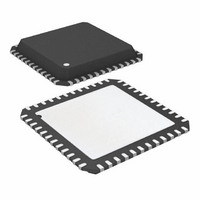ADF7025BCPZ-RL7 Analog Devices Inc, ADF7025BCPZ-RL7 Datasheet - Page 19

ADF7025BCPZ-RL7
Manufacturer Part Number
ADF7025BCPZ-RL7
Description
IC,RF Modulator/Demodulator,LLCC,48PIN,PLASTIC
Manufacturer
Analog Devices Inc
Datasheet
1.ADF7025BCPZ.pdf
(44 pages)
Specifications of ADF7025BCPZ-RL7
Frequency
431MHz ~ 464MHz, 862MHz ~ 870MHz and 902MHz ~ 928MHz
Data Rate - Maximum
384kbps
Modulation Or Protocol
FSK
Applications
Keyless Entery, Home Automation, Wireless Audio/Video
Power - Output
-20dBm ~ 13dBm
Sensitivity
-104dBm
Voltage - Supply
2.3 V ~ 3.6 V
Current - Receiving
19mA
Current - Transmitting
28mA
Data Interface
PCB, Surface Mount
Antenna Connector
PCB, Surface Mount
Operating Temperature
-40°C ~ 85°C
Package / Case
48-LFCSP
Operating Temperature (min)
-40C
Operating Temperature (max)
85C
Operating Temperature Classification
Industrial
Modulation Type
FSK
Product Depth (mm)
7mm
Product Length (mm)
7mm
Operating Supply Voltage (min)
2.3V
Operating Supply Voltage (typ)
2.5/3.3V
Operating Supply Voltage (max)
3.6V
Lead Free Status / RoHS Status
Lead free / RoHS Compliant
For Use With
EVAL-ADF70XXEKZ1 - KIT DEV ADF702X FOR BF533EZKITEVAL-ADF7025DBZ1 - BOARD EVAL ADF7025 902-928MHZ
Memory Size
-
Lead Free Status / Rohs Status
Compliant
Tx/Rx SELECT
RECEIVER
RF FRONT END
The ADF7025 is based on a fully integrated, zero-IF receiver
architecture. The zero-IF architecture minimizes power
consumption and the external component count while avoiding
the need for image rejection.
Figure 27 shows the structure of the receiver front end. The
numerous programming options allow users to trade off
sensitivity, linearity, and current consumption against each
other in the way best suitable for their applications. To achieve a
high level of resilience against spurious reception, the LNA
features a differential input. Switch SW2 shorts the LNA input
when transmit mode is selected (R0_DB27 = 0). This feature
facilitates the design of a combined LNA/PA matching network,
avoiding the need for an external Rx/Tx switch. See the
LNA/PA Matching section for details on the design of the
matching network.
The LNA is followed by a quadrature downconversion mixer,
which converts the RF signal direct to baseband. The output
frequency of the synthesizer must be programmed to the value
equal to the center frequency of the received channel.
The LNA has two basic operating modes: high gain/low noise
mode and low gain/low power mode. To switch between the
two modes, use the LNA_mode bit, R6_DB15. The mixer is also
configurable between a low current and an enhanced linearity
mode using the mixer_linearity bit, R6_DB18.
LNA/MIXER ENABLE
[R0_DB27]
LNA CURRENT
[R6_DB(16:17)]
[R9_DB(20:21)]
RFINB
LNA MODE
[R6_DB15]
RFIN
LNA GAIN
[R8_DB6]
Figure 27. ADF7025 RF Front End
SW2
LNA
LO
I (TO FILTER)
Q (TO FILTER)
MIXER LINEARITY
[R6_DB18]
Rev. A | Page 19 of 44
Based on the specific sensitivity and linearity requirements of
the application, it is recommended to adjust control bits
LNA_mode (R6_DB15) and mixer_linearity (R6_DB18).
The gain of the LNA is configured by the LNA_gain field,
R9_DB [20:21] and can be set by either the user or the
automatic gain control (AGC) logic.
Filter Settings/Calibration
Out-of-band interference is rejected by means of a fifth-order,
low-pass filter (LPF). The bandwidth of the filter can be
programmed to be ±300 kHz, ±450 kHz, or ±600 kHz by means
of Control Bits R1_DB [22:23] and should be chosen as a
compromise between interference rejection and attenuation of
the desired signal. A high-pass filter is also included as part of
the low-pass filter to prevent against dc offset problems. The
bandwidth of this filter is ~60 kHz. To avoid significant loss of
FSK modulated signal in the filter, the frequency deviation
needs to be significantly larger than this pole (refer to the
Modulation Index section). The minimum allowable frequency
deviation is 100 kHz.
To compensate for manufacturing tolerances, the LPF should
be calibrated once after power-up. The LPF calibration logic
requires that the LPF divider in Bits R6_DB [20:28] be set
depending on the crystal frequency. Once initiated by setting
Bit R6_DB19, the calibration is performed automatically
without any user intervention. The calibration time is 200 µs,
during which the ADF7025 should not be accessed. It is
important not to initiate the calibration cycle before the crystal
oscillator has fully settled. If the AGC loop is disabled, the gain
of LPF can be set to three levels using the filter_gain field,
R9_DB [20:21]. The filter gain is adjusted automatically, if the
AGC loop is enabled.
ADF7025












